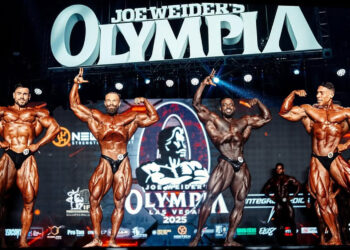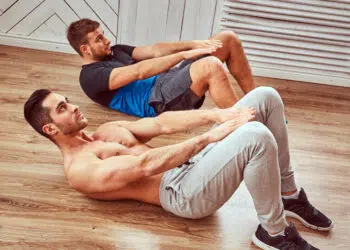Lower back pain, increasingly prevalent due to the modern lifestyle, will likely affect more people in the coming years.
In fact, a study published in the Annals of Translational Medicine concluded that the difference in the number of people affected by lower back pain syndrome from 1990 to 2017 jumped from 377.5 to 577.0 million. (1)
This should be reason enough to strengthen your posterior chain and core muscles. The dumbbell good morning is one of the best exercises to strengthen your posterior chain.
Good mornings activate your hams, glutes, and erector spinae significantly while forcing your abdominal muscles to be active since they prevent lumbar lordosis. (2)
In this article, I will cover how to perform dumbbell good mornings correctly; the muscles worked, benefits, variations, and alternatives.
How to Correctly Perform a Dumbbell Good Morning
This is how to perform dumbbell good mornings to maximize your lifting performance:
Level Up Your Fitness: Join our 💪 strong community in Fitness Volt Newsletter. Get daily inspiration, expert-backed workouts, nutrition tips, the latest in strength sports, and the support you need to reach your goals. Subscribe for free!
Step One — Assume the Starting Position
Pick a dumbbell of appropriate weight and hold it with both hands at your clavicle bone level. Assume a starting standing position with your feet hip-width apart. Keep your knees extended, your back straight (physiologically neutral position), and your gaze fixed ahead.
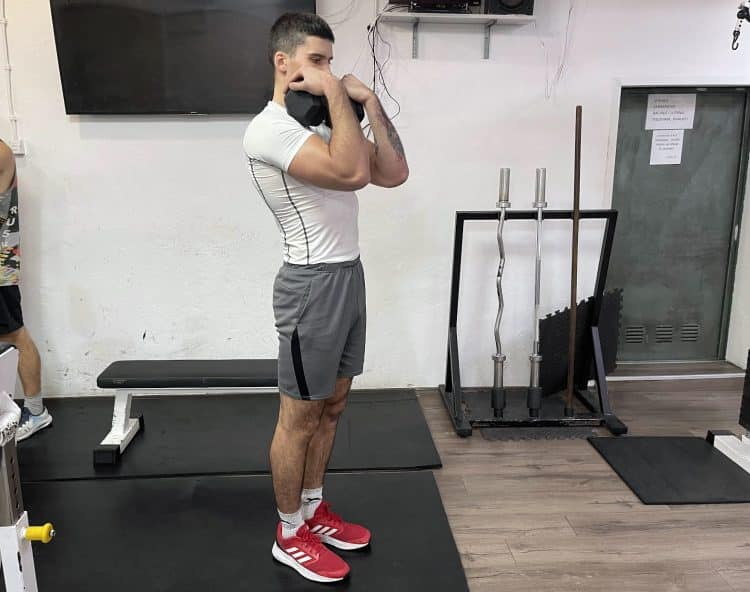
Pro Tip: If you are also experiencing knee problems, flex them and keep them in the same position during the entire exercise. The goal is to perform the slightest knee flexion. Otherwise, we are basically doing Romanian deadlifts.
Step Two — Eccentric Phase
Start the exercise by hinging at the hips and lowering your torso towards the floor. Keep your back straight the entire time to avoid injuries. Make sure your knees are slightly flexed as well. Your torso should ideally be parallel to the floor at the bottom. Hold the bottom position for one second before completing the next step.
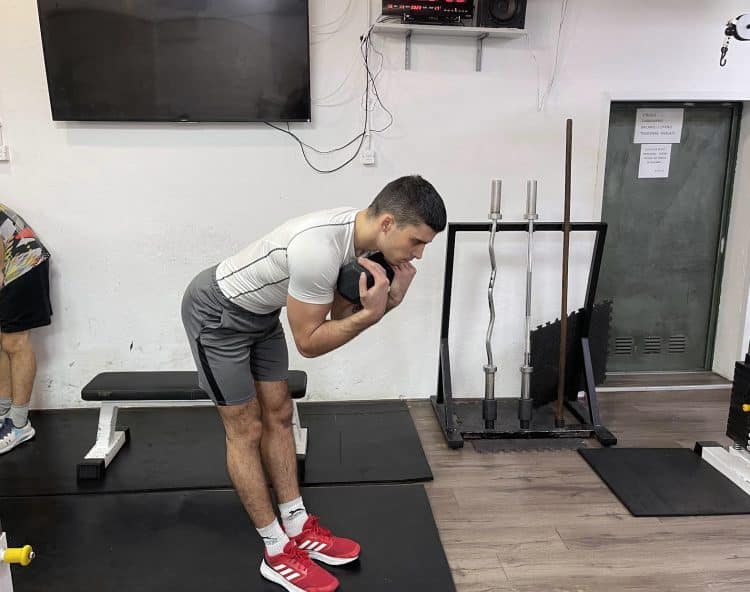
Pro Tip: Contract your muscles to stabilize your lumbar back and prevent lordosis.
Step Three — Concentric Phase
Extend your hips to return to the starting standing position. One rep is finished when your hips are again in the neutral position and knees extended. Perform for the desired amount of reps.
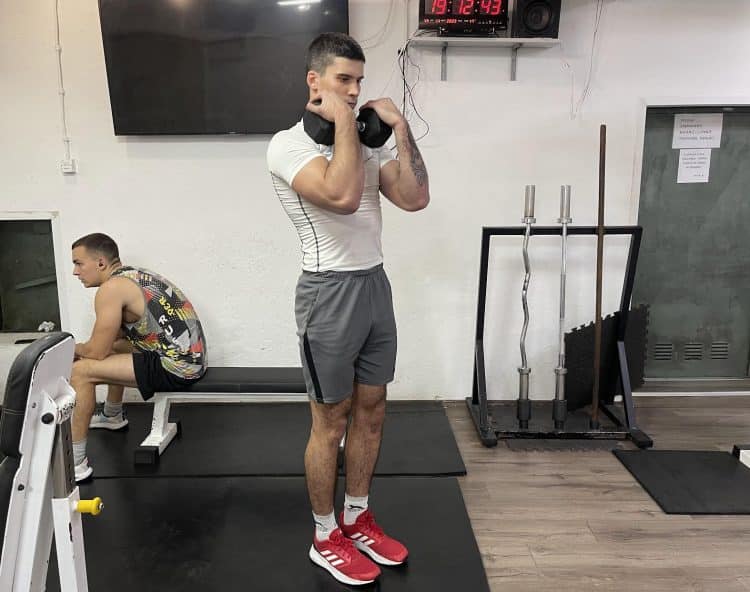
Pro Tip: Try to complete the concentric phase as fast as possible to force those fast twitch fibers to activate. This will result in both types of muscle fibers, fast and slow, to be activated so you can induce better hypertrophy, strength, and power effects.
What Muscles Do Dumbbell Good Mornings Target?
Here are the primary muscles:
- Hamstrings (biceps femoris, semitendinosus, semimembranosus)
- Glutes (maximus, medius, and minimus)
- Erector spinae
Also, here are the secondary muscles:
- Core (obliquees, transversus abdominis, and rectus abdominis)
- Adductors (gracilis, adductor brevis/longus/magnus)
- Additional small lower back muscles
- Upper back and shoulders (these are primarily for keeping a good posture during the exercise)
Benefits of Performing Dumbbell Good Mornings
Doing dumbbell good mornings offers multiple benefits, such as strengthening the lower back, activating the hamstrings and glutes, improving hip hinge mechanics, engaging the core, and boosting proprioception.
Lower Back Strengthening
The dumbbell good morning exercise is an excellent choice for all those seeking to strengthen their lower back muscles. Here, we are primarily talking about the electro spinae, the muscle that spreads along the whole spine between our vertebras’ processus transverses and processus spinosus.
This muscle is key for alleviating your lower back pain, along with other posterior and core muscles as well.
Hamstring and Glute Activation
Hip hinge movements always require activation of posterior chain lower body muscles such as hamstrings and glutes. Dumbbell good mornings will effectively strengthen your hamstring muscles, such as biceps femoris, semitendinosus, and semimembranosus, while also activating your glute muscles, such as gluteus medius, minimus, and maximus.
Those are key to good posture and a stable spine, which are highly likely to alleviate excessive lower back pain.
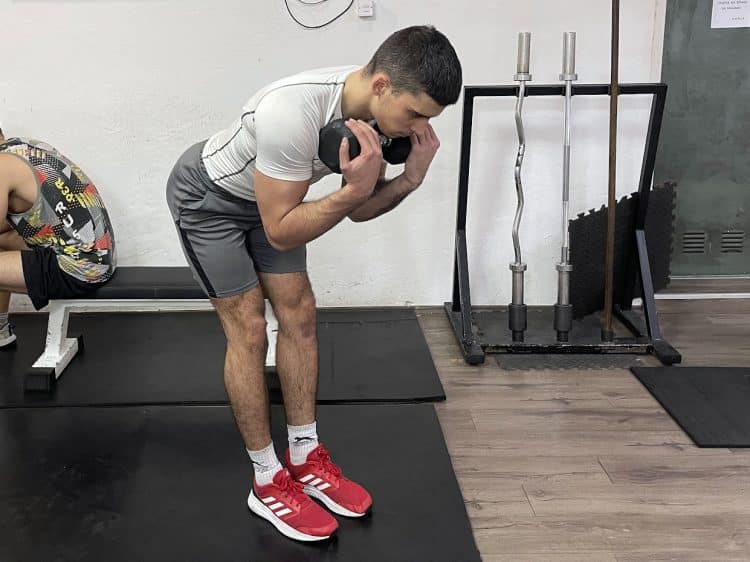
Improved Hip Hinge Mechanics
There is no doubt that dumbbell good mornings will improve your overall hip hinge mechanics because they are primarily based on performing hip flexion and extension movements.
This is huge because you can use that to perform other biomechanically similar exercises, including barbell deadlifts, barbell bilateral and unilateral Romanian deadlifts, and hyperextensions, more easily and with better performance.
Core Engagement
Dumbbell good mornings are highly effective at activating a wide variety of your core muscles. Some of these include obliquus internus, obliquus externus, transversus abdominis, and rectus abdominis. These are key for building a functional, stable, and resilient core that will protect your lower back from excessive exposure.
Enhanced Proprioception and Balance
The dumbbell good morning is a highly demanding proprioceptive exercise because it requires you to stabilize the dumbbell and your body simultaneously in the same plane of motion but only with your posterior chain muscles.
Level Up Your Fitness: Join our 💪 strong community in Fitness Volt Newsletter. Get daily inspiration, expert-backed workouts, nutrition tips, the latest in strength sports, and the support you need to reach your goals. Subscribe for free!
Also, holding the dumbbell at your clavicle bone level isn’t the same as holding the dumbbell, for example, when performing lunges. Holding the dumbbell at your clavicle bone level is much more challenging because it requires better core stability and endurance for long isometric contraction of your arms, shoulders, chest, and upper back muscles.
Dumbbell Good Morning Variations and Alternatives
Below are the best dumbbell good morning variations and alternatives:
Barbell Good Morning
Barbell good morning is a progression exercise to the dumbbell good morning. It can be loaded with drastically more weights, but you should remember that lower back exposure is much greater during this variation.
Barbell good mornings are also highly effective at strengthening your posterior chain muscles such as hamstrings, glutes, and erector spinae.
Steps:
- Load the barbell with appropriate weight and place it on your upper back, just like while performing back squats.
- Assume a hip-width stance with your feet, extend your knees, and keep your hips neutral and back in a straight line during the entire exercise.
- Start the exercise by flexing the hips and lowering your torso toward the floor.
- Your torso should be parallel to the floor at the bottom. Hold this position for one second.
- Reverse the motion to return to the starting position.
- Repeat for the desired number of reps.
Pro Tip: Focus on pushing your hips back and maintaining a slight bend in your knees, as this helps maximize hamstring engagement while reducing lower back strain. Keep your head in a neutral position aligned with your spine, as this promotes better posture and reduces the risk of neck strain.
Barbell Romanian Deadlift
Barbell Romanian deadlift is biomechanically very similar to good mornings. The major difference between these two exercises is your knee position and the depth.
Also, one more difference is external weight placement. Good mornings are performed with the weight close to your neck level, while Romanian deadlift variations are performed with the weight next to your lower body.
Steps:
- Place the barbell on the floor and load it with appropriate weight.
- Assume a standing position hip-width apart in front of the barbell so your shins almost touch it.
- Grab the barbell with an overhand shoulder-width grip.
- Lift the barbell off the floor and transition to the standing position.
- Slightly bend your knees and keep them in the same position during the entire exercise. Keep your back straight as well.
- Start the exercise by flexing your hips and lowering the bar towards the floor.
- When your wrists pass your knee level, hold that position for one second.
- Reverse the motion to return to the starting position.
- Repeat for the desired number of reps.
Pro Tip: Concentrate on keeping the barbell close to your legs throughout the movement; this ensures better leverage and minimizes strain on your lower back. Also, initiate the movement by pushing your hips back, rather than bending at the waist, to target the hamstrings and glutes while maintaining spinal integrity effectively.
Traditional Barbell Deadlift
The traditional barbell deadlift is one of the three big lifts in powerlifting. It builds incredible strength levels, improves your overall posture, and activates every muscle in your body.
Steps:
- Place the barbell on the floor and load it with the appropriate weight.
- Assume a standing position around hip-width apart in front of the barbell so your shins almost touch it.
- Grab the barbell with a shoulder-wide overhand or mixed grip.
- Keep your back straight during the entire exercise.
- Perform a triple extension to lift the barbell. This means extending your ankles, knees, and hips simultaneously.
- When you are in the top position, hold for one second.
- Reverse the motion to return the barbell to the floor and repeat for the desired reps.
Pro Tip: Engage your core and keep your chest up throughout the lift. It will aid in maintaining a neutral spine and prevent rounding of the back, reducing the risk of injury.
Single-Leg Barbell Romanian Deadlift
The single-leg Romanian deadlift is one of my favorite unilateral exercises for strengthening the posterior chain muscles. It requires substantial coordination and stability to execute correctly.
Steps:
- Place the barbell on the floor and load it with the appropriate weight.
- Assume a standing position hip-width apart in front of the barbell and take an overhand grip on the bar just outside your legs.
- With your back straight, lift the barbell off the floor. Your shoulders, hips, knees, and ankles should be stacked in this position.
- Start the exercise by lifting your left leg off the floor and bending forward.
- As you do so, lift your left leg behind and towards the ceiling while lowering your torso towards the floor.
- When the barbell passes below knee level, hold that position for one second.
- Reverse the motion to return to the starting position.
- Repeat for the desired number of reps.
Pro Tip: Focus on a slow, controlled descent and visualize reaching back with your free leg, which helps maintain balance and ensures proper alignment throughout the exercise.
Stability Ball Hyperextension
Stability ball hyperextension is an advanced exercise that isolates your posterior chain muscles.
Steps:
- Place your exercise ball on the floor and lie on it on your stomach.
- Start the exercise by bending at your hips and lowering your torso towards the ground.
- When you reach the end range of motion, hold for one second.
- Reverse the motion by hyperextending your hips and lower back.
- Repeat for the desired amount of reps.
Pro Tip: Position the ball under your hips and lower torso, and anchor your feet against a sturdy surface to prevent rolling, ensuring a stable and effective range of motion.
FAQ’s
How much weight should I use on the dumbbell good mornings?
You should use between 60 and 80% of your dumbbell deadlift one rep max (1RM) when performing good mornings. This is more than enough to correct your posture, build strength, induce hypertrophy, and teach your posterior chain muscles how to handle hip hinge movement patterns accordingly.
Are good mornings the same as RDL?
No, good mornings and Romanian deadlifts are not the same. First, the weight placement is different; good mornings require the weight to be placed at shoulder level, and Romanian deadlifts involve holding the dumbbells against your legs.
Second, there is more knee flexion during Romanian deadlifts, whereas your knees are extended during good mornings.
Are good mornings better than squats?
Good mornings are better at isolating your posterior chain muscles. On the other hand, squats are better for overall leg development. I would also pick squats over good mornings for developing strength and power in my lower limbs.
Wrapping Up
Dumbbell good mornings are excellent for developing posterior chain muscle strength. They are also a great exercise for building your core strength and lumbar spine stability, a lack of which often translates to lower back pain and better overall posture.
In the comments below, let me know your thoughts on dumbbell good mornings and how you incorporate them into your current workout routine.
More Variation of Good Mornings:
- Barbell Good Morning Exercise Guide
- Smith Machine Bent-Knee Good Morning
- Seated Good Morning Exercise Guide
References
- Wu A, March L, Zheng X, et al. Global low back pain prevalence and years lived with disability from 1990 to 2017: estimates from the Global Burden of Disease Study 2017. Ann Transl Med. 2020;8(6):299. doi:10.21037/atm.2020.02.175
- Vigotsky AD, Harper EN, Ryan DR, Contreras B. Effects of load on good morning kinematics and EMG activity. PeerJ. 2015;3:e708. Published 2015 Jan 6. doi:10.7717/peerj.708
Interested in measuring your progress? Check out our strength standards for Good Morning, Deadlift, Romanian Deadlift, and more.




